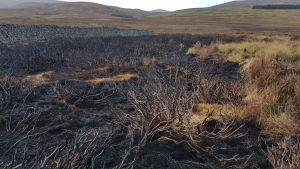In 2006 the North Pennines AONB Partnership set up its peatland programme to raise awareness about, and to begin to restore, England’s largest blanket bog. Initially the restoration focus was on blocking the 10,000km of grips that had been cut into the peat body since World War Two. However, starting with one small site in 2010 the AONB’s Peatland Team are now restoring bare peat across numerous sites in the North Pennines. With 2800ha of bare peat in the North Pennies this is just the start but, after developing new techniques for the 2013 restoration season, results are already looking promising. Damaged moorland is being transformed into a moss-covered landscape, which will help stabilise the peat and allow heather and grasses to colonise the previously bare ground.
Pictures 1 & 2: One of the restoration sites with heather brash waiting to be spread in October 2013 and the site in September 2015.
Typically a bare peat site in the North Pennines is a series of fragment haggs with erosion channels running through them with patchy vegetation on the hagg tops. These sites are frequently surrounded by comparatively good bog which contains a mix of dwarf shrubs, cotton grasses and Sphagnum mosses. Restoration work is based on a five-step process that the team has developed which includes fencing off the land to protect it from grazing, spreading cut heather to protect the bare peat from erosion, control of any water causing erosion and techniques to re-establish plant growth including small amounts of phosphate based fertiliser, moorland seed and introducing Sphagnum. Results so far show that a moss layer is forming within the first growing season over the bare peat allowing the sedges, grasses and dwarf shrubs, to establish at a slightly slower rate. The moss layer is dominated mosses associated with dry heath land such as Pleurozium schreberi, Rhytidiadelphus squarrosus and Hypnum jutlandicum. If Sphagnum has been present on the heather brash donor site or close to the restoration site then small fragments are increasingly been seen in this moss layer.
To help attempt to get the restoration sites back to functioning blanket bog as quickly as possible we have also introduced clumps or handfuls of Sphagnum to the restoration sites (see photo on left). Focusing on hummock forming and flush species the moss is harvested by hand and planted within the wetter areas on the restoration site. Predominately, S. palustre and S. fallax with S. capillifolium and S. magellnicum. Not only has the planted Sphagnum clumps survived, they are already showing signs of spreading (see photo bottom right).
Bare peat restoration using our current combination of techniques only began in 2013. We hope that from here the vegetation will continue to establish and move towards a healthy functioning peatland that is able to accumulate peat and store huge amounts of carbon. All sites are being monitored and further intervention may be needed in future years. However, peat restoration is a costly job and the money for this work ultimately comes from grant funding. This first round of work was made possible thanks to a £500,000 grant from Biffa Award. The Peatland Programme team are currently working with our partners to find funds for the next round of works.
Emma Taylor, North Pennines AONB Partnership










